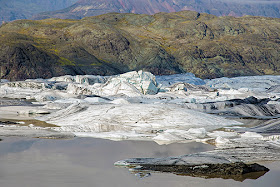
A man in Reykjavik told us: "I love this this entire country but if I had only one choice, I would travel the South. The diversity of natural phenomena there is mind boggling. You get a bit of everything - glaciers, volcanoes, flood plains, birds ....make sure not to miss the South!"
 The southern part of our exploration started in a small fishing community of Höfn. From there we would make our way south-west experiencing tiny bits of the vast
The southern part of our exploration started in a small fishing community of Höfn. From there we would make our way south-west experiencing tiny bits of the vast
Vatnajökull National Park. It did not take long to discover a tempting sign:
Hoffellsjökull - seven short kilometers away!

Hoffellsjökull - seven short kilometers away!
Asphalt did not last long - soon it turned into a well maintained dirt road, much more suitable to the tundra at the bottom of lava fields.
There it was - Hoffellsjökull - our first glacier of the day!
Complete with a lagoon and a terminal moraine.


Vast and wild places make the mind wonder.
Right there, studying the volcanic rocks and the ancient glacier, side by side, it became more than clear that, contrary to many-a-man belief, human race does NOT have the upper hand over Nature.
Yes, we are increasingly capable of destroying anything (living or not)
but when enough is enough Nature does, will, and shall, revolt.

In the life of a glacier "turquoise" means old; very old.
It means that, over the millennia, all the air had been pressed out of the ice giving it an appearance of a precious gem.

 The tundra surrounding the ice field was teaming with plant life. Numerous, but compact and tiny in size, to escape the ever-present wind and cold, the plants bore witness to the resilience of life.
The tundra surrounding the ice field was teaming with plant life. Numerous, but compact and tiny in size, to escape the ever-present wind and cold, the plants bore witness to the resilience of life.
Hoffellsa - the glacial river did not have to travel very far to meet the sea. Ten kilometers at the most.

Another stop featured Fjallsjökull, another glacier calving off the fields of the king of them all - the mighty Vatnajökul.
The sign was advertising a glacial lake and, of course, the tours.
Above that beauty rose another phenomena: an ice-covered volcano named Öræfajökull.
Volcanoes and glaciers working together!
All we could think of was: "And when Hell freezes over ..."
Finally - there was the famous Jökulsárlón.
This large glacial lake adjacent to Ring Road and, not far from it, empties into the sea
And that accounts for large numbers of visitors, large number of birds and an occasional seal looking for a fish.
 Lucky weather-wise, for once, we photographed, studied and walked all at once. The chunks of ice were moving fast, sometime dancing in circles, their peaks occupied by scores of squabbling seabirds.
Lucky weather-wise, for once, we photographed, studied and walked all at once. The chunks of ice were moving fast, sometime dancing in circles, their peaks occupied by scores of squabbling seabirds.
Like an old, wise turtle, this chunk of ancient ice floated by.
What happened to the planet during its long existence?
There was no way to tell - nearing the end it was just gently making its way towards the sea.
Watching it all, preening in the sun, was a young snow bunting, Plectrophenax nivalis, It may have been born somewhere near among the rocks.
Still mostly brown it would eventually change its plumage to an elegant black and white.
But it was September and the breeding season was some nine long and dark months away.
It was hard to leave that wild and dazzling part of the world: the world of
cool white glaciers, undermined by the sizzling volcanoes.
The glaciers grudgingly slithering down the mountains and reluctantly releasing water that they trapped thousands of years ago.
Allowing it to run away towards the open sea; freedom at last!
It floods the plains below, rearranges the boulders, creates lakes, rivers and waterfalls.
Away and away it runs - back to the cycle of life.













No comments:
Post a Comment